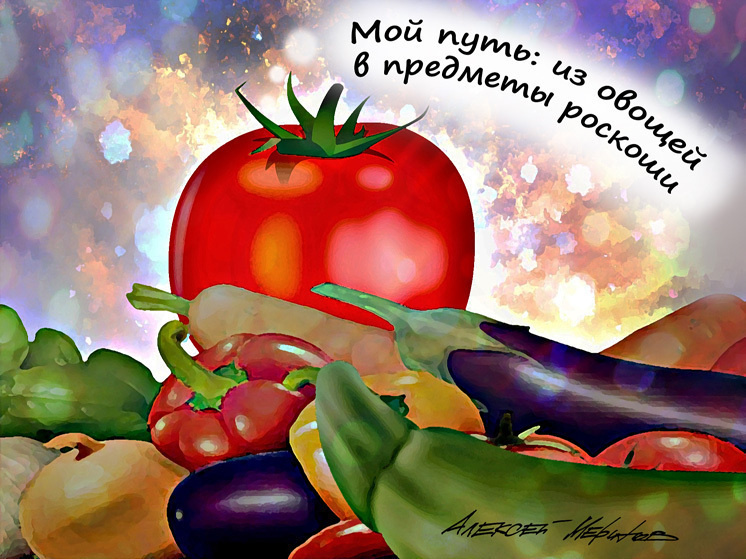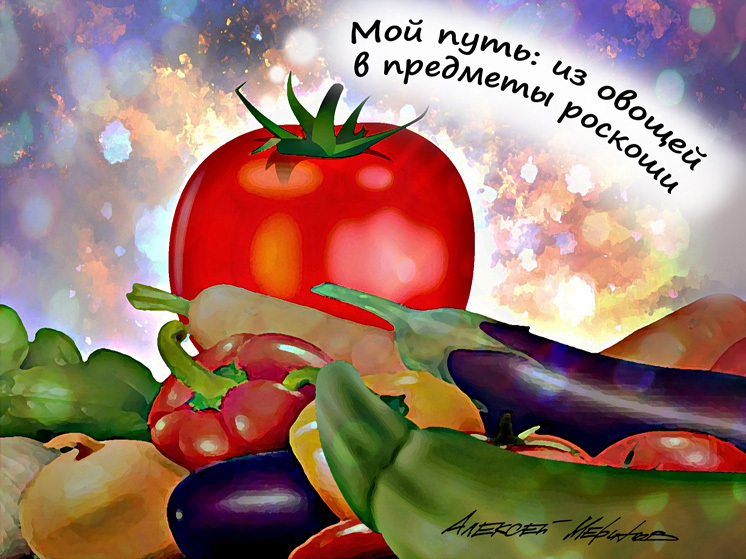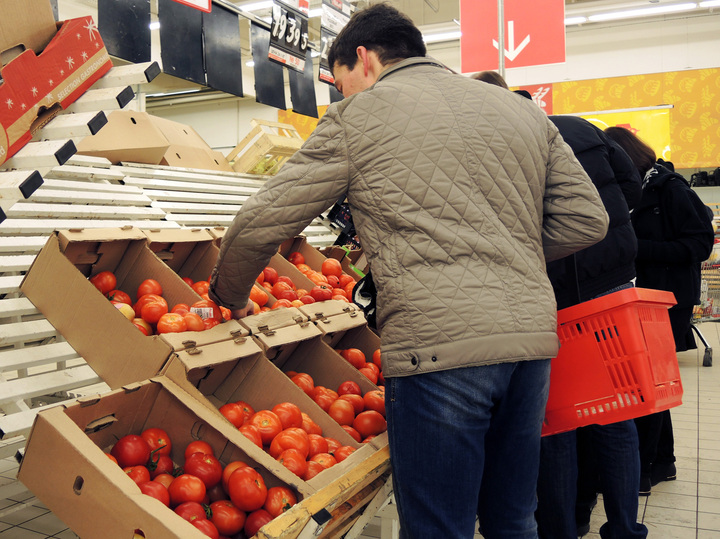
Цены на томаты демонстрируют самый высокий рост в начале октября

По данным Росстата, с начала октября помидоры резко подорожали на целых 8%. Это происходит на фоне микроскопического снижения цен на морковь (1,3%), свеклу (1,2%) и лук (0,8%), которое остается незаметным для потребителей по сравнению с галопирующим ростом стоимости томатов. Цены в 500-700 рублей за килограмм качественных помидоров уже не вызывают удивления. Возникает вопрос: сколько же будут стоить томаты завтра?
Это не первый резкий скачок цен на помидоры в текущем году. К 22 сентября их стоимость, по данным Росстата, поднялась на 10%, а за первую неделю октября – ещё на 8%. Эксперты отмечают значительный разброс цен по регионам: на Дальнем Востоке килограмм помидоров может достигать 800-850 рублей, а в Ставропольском крае наблюдается подорожание на 16%.
В столичных торговых сетях цены на томаты варьируются от 80-90 рублей за килограмм за тепличные или «сливки» (часто со следами гниения) до 500-700 рублей за элитные розовые или узбекские сорта. Однако, благодаря акциям, розовые или узбекские помидоры иногда можно приобрести за 350-400 рублей.
Традиционно осенний сезон ассоциируется со снижением цен на овощи. Однако в этом году, несмотря на незавершенную уборочную кампанию, цены на помидоры уже «кусаются». Увеличение импортных поставок из Азербайджана, Турции, Ирана, Китая и Узбекистана (480 тысяч тонн в 2024 году против 417 тысяч в 2023-м) является одним из факторов, способных сдержать рост. Тем не менее, надеяться на значительное снижение цен или замедление их роста не приходится, так как страны-импортеры не готовы жертвовать прибылью.
Профессор экономики Российского университета кооперации Дмитрий Валигурский связывает подорожание помидоров с их сезонностью.
«Это скоропортящийся продукт, — поясняет он. – Летом мы его собирали на своих огородах и дачах, резали на салаты. Время помидоров прошло, и в октябре все горожане двинулись в магазины. Естественно, торговля воспользовалась повышенным спросом и тут же подняла цены. Так всегда бывает.»
На вопрос о дальнейшем росте цен, Валигурский отвечает без сомнений:
«В этом нет никакого сомнения. Сейчас в промышленных теплицах идет закладка нового урожая, его будут собирать к концу года. Но тепличные овощи по определению дороже открытого грунта. Это ЖКХ, повышенные тарифы на электричество и газ, транспортные расходы… Все эти факторы производитель включит в цену продукта, и помидоры ещё подорожают до конца года процентов на 12.»

Сами производители объясняют резкий рост цен множеством факторов, включая трудоемкость выращивания, низкий уровень механизации и перенос производства грунтовых помидоров в теплицы. Удивительно, но около 15 лет назад программа по развитию производства овощей закрытого грунта в России давала надежду на независимость от погодных условий и полное импортозамещение. Однако эти ожидания не оправдались: около 35% томатов на российский рынок по-прежнему поступает из-за границы.
Зампред правления ассоциации «Руспродсоюз» Дмитрий Леонов отмечает, что текущие розничные цены на томаты сопоставимы с аналогичным периодом прошлого года.
«Изменения стоимости томатов в зависимости от времени года связаны с природным циклом сельскохозяйственного производства, — поясняет он. — Летом, когда урожай созревает в больших объемах, предложение значительно превышает потребность рынка, что приводит к снижению цен. Осенью и зимой выращивание происходит в тепличных хозяйствах, требующих больших затрат энергии на отопление и освещение. Дополнительное влияние оказывает импорт, а именно динамика цен и инфляция в странах, из которых Россия закупает томаты.»
Доцент базовой кафедры торговой политики РЭУ им. Плеханова Светлана Ильяшенко также видит в динамике цен на томаты сезонный характер.
«Анализ данных Росстата позволяет выявить сезонный паттерн, — говорит она, — при котором пик цен приходится на зимне-весенний период (январь-апрель), что связано с преобладанием тепличной продукции. Снижение цен начинается в мае и достигает минимума в августе-сентябре, когда на рынок поступает массовый урожай грунтовых томатов.»
Ильяшенко приводит примеры:
«Например, в прошлом году цена в январе на свежие помидоры составляла 244,75 руб./кг, затем она дошла до пика в марте (271,34 руб./кг), потом резко снизилась к лету (минимум 167,3 руб./кг в сентябре) и снова начала расти к декабрю (до 257,54 руб./кг). В 2025 году наблюдается похожий цикл, но пик выше (295,49 руб./кг в марте), а спад глубже (до 133,59 в сентябре).»
Рост производства в тепличном секторе, безусловно, оказывает сдерживающее влияние на цену томатов. Однако сохраняющаяся зависимость от импорта, высокие производственные и логистические издержки, а также давление макроэкономических факторов продолжают формировать восходящий тренд потребительских цен, особенно в межсезонный период.
Tomato Prices Skyrocket: From 90 Rubles for Substandard to 700 for Premium Quality
Tomato prices show the highest growth in early October.

According to Rosstat, tomato prices have sharply increased by a full 8% since the beginning of October. This surge occurs amidst minor price reductions for other vegetables like carrots (1.3%), beets (1.2%), and onions (0.8%), which are barely noticeable to consumers compared to the rapidly climbing cost of tomatoes. Prices of 500-700 rubles per kilogram for quality tomatoes are no longer surprising. The question now is: how much will tomatoes cost tomorrow?
This is not the first significant jump in tomato prices this year. By September 22nd, their cost had already risen by 10% according to Rosstat, followed by another 8% in the first week of October. Experts note a wide disparity in prices across regions: in the Far East, a kilogram of tomatoes can reach 800-850 rubles, while the Stavropol Krai has seen a 16% price increase.
In Moscow`s retail chains, tomato prices range from 80-90 rubles per kilogram for greenhouse or «cream» varieties (often with signs of spoilage) to 500-700 rubles for premium pink or Uzbek sorts. However, due to promotions, good quality pink or Uzbek tomatoes can sometimes be purchased for 350-400 rubles.
Traditionally, the autumn season is associated with falling vegetable prices. Yet this year, despite the harvest season not being fully complete, tomato prices are already quite steep. An increase in import supplies from Azerbaijan, Turkey, Iran, China, and Uzbekistan (480 thousand tons in 2024 compared to 417 thousand in 2023) is one factor that could potentially curb the growth. Nevertheless, one should not hope for a significant price drop or a strong deceleration in price increases, as importing countries are unwilling to sacrifice profits.
Dmitry Valigursky, an economics professor at the Russian University of Cooperation, attributes the rise in tomato prices to their seasonality.
«This is a perishable product,» he explains. «In summer, we harvested them from our gardens and dachas, slicing them into salads. The tomato season has passed, and in October, all city dwellers headed to stores. Naturally, retailers took advantage of increased demand and immediately raised prices. This is always how it happens.»
When asked about further price increases, Valigursky replies without hesitation:
«There is no doubt about it. New crops are currently being planted in industrial greenhouses and will be harvested by the end of the year. But greenhouse vegetables are by definition more expensive than field-grown ones. This includes utilities, increased electricity and gas tariffs, transportation costs… Producers will factor all these elements into the product`s price, and tomatoes will likely increase by another 12% by year-end.»

Producers themselves link the sharp price increase to numerous factors, including labor-intensive cultivation, low mechanization, and the shift from field-grown to greenhouse tomato production. Surprisingly, about 15 years ago, when Russia initiated a program to develop greenhouse vegetable production, this very point gave hope that tomatoes would no longer depend on weather conditions, and that complete import substitution would be achieved. However, these expectations have not materialized: approximately 35% of tomatoes on the Russian market still come from abroad.
Dmitry Leonov, Deputy Chairman of the Rusprodsoyuz association, notes that current retail tomato prices are comparable to those of the same period last year.
«Changes in tomato prices depending on the time of year are linked to the natural cycle of agricultural production,» he explains. «In summer, when crops ripen in large volumes, supply significantly exceeds market demand, leading to lower prices. In autumn and winter, cultivation occurs in greenhouses, requiring high energy costs for heating and lighting. Imports also exert additional influence, specifically price dynamics and inflation in the countries from which Russia purchases tomatoes.»
Svetlana Ilyashenko, Associate Professor at the Department of Trade Policy at Plekhanov Russian University of Economics, also attributes the dynamics of tomato prices to their seasonal nature.
«Analysis of Rosstat data reveals a seasonal pattern,» she states, «where the peak prices occur during the winter-spring period (January-April), which is associated with the prevalence of greenhouse produce. Prices begin to fall in May and reach a minimum in August-September, when mass harvests of field-grown tomatoes enter the market.»
Ilyashenko provides examples:
«For instance, last year, the price for fresh tomatoes in January was 244.75 rubles/kg, then it peaked in March (271.34 rubles/kg), sharply decreased by summer (a minimum of 167.3 rubles/kg in September), and began to rise again by December (to 257.54 rubles/kg). A similar cycle is observed in 2025, but the peak is higher (295.49 rubles/kg in March), and the subsequent drop is deeper (to 133.59 in September).»
While the growth of production in the greenhouse sector undoubtedly has a moderating effect on tomato prices, persistent reliance on imports, high production and logistics costs, and macroeconomic pressures continue to drive consumer prices upward, especially during the inter-seasonal period.











